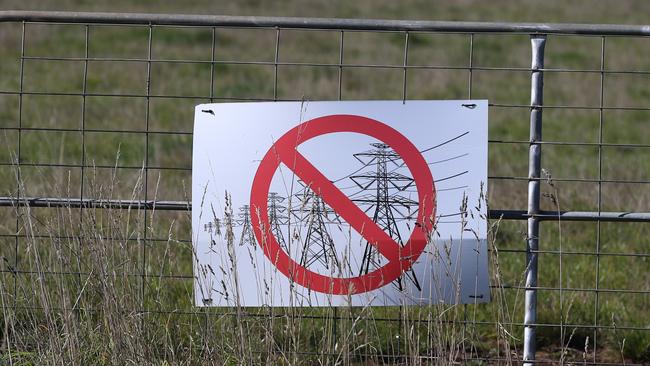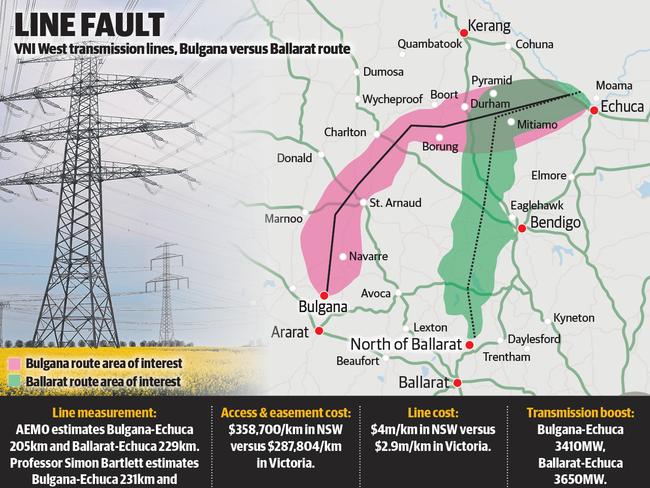Power failure: Major faults in AEMO’s VNI West costings
Major faults have been unearthed in the costings of the $3.28 billion Victoria-NSW Interconnector transmission project — which will carve up 400km of farmland.

Major flaws have been exposed in the business case justifying construction of a $3.282 billion power transmission line that will carve its way through 400km of farmland in northwest Victoria and the NSW Riverina.
The Australian Energy Market Operator, which is overseeing planning for the Victoria-NSW Interconnecter West project, estimates the cost of paying landholders for easements will be significantly less in Victoria at $287,804/km, compared with $358,700/km in NSW.
AEMO’s analysis also states construction of the 500kV powerline – which will be strung across hundreds of rural properties from Bulgana to Dinawan, near Jerilderie, requiring 60-80m towers be built on 100m-wide easements – will have “comparatively little impact on high potential agricultural land”.
Gooroc grain grower Gerald Feeny, whose property is within the Bulgana corridor, said AEMO’s “city-centric view of rural land was insulting, insensitive and showed little concern for 150 years of farming”.
Electrical engineer and former chair of transmission at the University of Queensland, Professor Simon Bartlett, has ridiculed AEMO’s report, which he says miscalculates line distances and costs.
“It’s a disaster,” Professor Barlett said. “It will cost mum and dad Australians dearly for years to come.”
AEMO originally selected a route for VNI West, in July last year, that ran from just north of Ballarat, straight through the heartland of two Labor-held electorates – Bendigo West and Ripon – to the NSW border near Echuca.
But after community backlash, AEMO reanalysed its options and last month dumped the Ballarat route in preference for a longer, more expensive and lower capacity Bulgana to Echuca corridor, avoiding Bendigo West and bypassing Ripon’s Labor-leaning regions.
Professor Bartlett’s deep dive into AEMO’s work shows it underestimated the length of the Bulgana-Echuca route at 205km, reducing its cost, while over-estimating the original Ballarat-Echuca route distance at 229km.
The actual distances measured using AEMO’s own mid-line analysis, by both Professor Bartlett and The Weekly Times, are 231km for the Bulgana route and 189km for the Ballarat route.

Nationals agriculture spokeswoman Emma Kealy said “it looks like politics was at play in moving the lines”.
But an AEMO spokesman said the government-owned corporation disputed any claim of political influence.
Victorian Energy Minister Lily D’Ambrosio refused to answer questions on whether she applied any political pressure on AEMO to shift the VNI West route from Ballarat to Bulgana.
Her office simply stated “AEMO have listened to feedback and is consulting on alternatives that will deliver better outcomes for local communities and energy consumers”.
AEMO’s options report also puts the cost of its miscalculated 205km Bulgana line at $597m, which equates to $2.9m/km for the Victorian section of VNI West, whereas it puts the cost of the 184km NSW share of the line at $751m, equal to $4m/km.
Professor Bartlett said “it costs virtually the same to build a 500kV line in southern NSW and Victoria, the same materials, the same labour costs. It’s (the report) totally flawed.”
When asked about the differing costs, an AEMO spokesman said “per kilometre costs vary by state due to land differences” and “varying easement land tax arrangements”.
As for the differences in line lengths between Bulgana-Echuca and Ballarat-Echuca routes, the AEMO spokesman said the “line length has been calculated within the area of interest and includes both 500kV and 220kV lines, where cutting into the existing 220kV network”.
AEMO’s report admits the Bulgana route has more areas “subject to inundation and therefore would require heightened attention to the management of flooding risk”.
“It also had greater technical engineering complexity due to the need for additional series compensation to help reduce impedances of the longer line route between network nodes.”
Professor Bartlett, who formerly ran Queensland’s transmission network as its chief operating officer, said previous attempts at using series compensation to boost transmission capacity by 190 megawatts through the South Australia-Victoria interconnector had delivered just half that target. AEMO’s analysis states the Bulgana route boosts Victoria-NSW transmission capacity by only 3410MW, compared to 3650MW for the Ballarat link. Connecting VNI West to Bulgana, instead of Ballarat, also means lifting the capacity of the Western Renewables Link from 220kV to 500kV at a cost of $315 million.
Professor Bartlett said AEMO’s analysis was a mess.
But challenges to AEMO’s analysis of both VNI West and the 190km Sydenham to Bulgana Western Renewables Link it taps into, have been blocked by Victorian Energy Minister Lily D’Ambrosio.
Last month Ms D’Ambrosio issued a ministerial order exempting both projects from challenges under the National Electricity Rules, after the Moorabool and Central Highlands Power Alliance filed an application with the Supreme Court action to quash AEMO’s WRL decision.
Read related topics:VNI West transmission line




